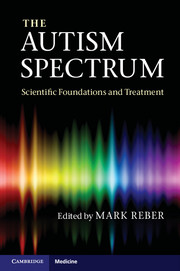Book contents
- Frontmatter
- Contents
- List of Abbreviations
- List of Contributors
- Preface
- Section 1 What We Know about Autism and How We Know It
- Chapter 1 Autism nosology
- Chapter 2 Epidemiology of autism
- Chapter 3 Developmental neuropsychology of autism
- Chapter 4 Neuropathology of autism
- Chapter 5 Etiology
- Chapter 6 Etiology
- Section 2 Assessing and Treating Children with Autism Spectrum Disorders
- Section 3 Assessing and Treating Adults with Autism Spectrum Disorders
- Index
- Plate Section
- References
Chapter 3 - Developmental neuropsychology of autism
from Section 1 - What We Know about Autism and How We Know It
Published online by Cambridge University Press: 05 November 2012
- Frontmatter
- Contents
- List of Abbreviations
- List of Contributors
- Preface
- Section 1 What We Know about Autism and How We Know It
- Chapter 1 Autism nosology
- Chapter 2 Epidemiology of autism
- Chapter 3 Developmental neuropsychology of autism
- Chapter 4 Neuropathology of autism
- Chapter 5 Etiology
- Chapter 6 Etiology
- Section 2 Assessing and Treating Children with Autism Spectrum Disorders
- Section 3 Assessing and Treating Adults with Autism Spectrum Disorders
- Index
- Plate Section
- References
Summary
The concept of “autism” originated with the Swiss psychiatrist Eugen Bleuler (1911), who coined the term to refer to the “detachment from the outside world” and the “preponderance of introversion” that he observed in adults with schizophrenia. Bleuler believed that the other pathological accentuation of autistic thinking that occurred in schizophrenia reflected a disintegration of mental function and was associated with other disturbances, including lack of initiative and persistence, aimlessness, impulsivity, bizarre behavior, disordered attention, obsessional and automatic acts, and loss of contact with reality.
Around this time, several reports suggested that the onset of this form of deterioration, previously referred to as dementia praecox, could emerge in children following a period of seemingly normal development (DeSanctis, 1908; Heller, 1908). In due course, the concept of autism was adopted to describe congenital forms of psychopathology in which children failed to develop adequate or appropriate levels of affective contact with others, instead remaining withdrawn and self-absorbed. The Russian neurologist Ewa Ssucharewa, for example, embraced the concept in describing an “autistic attitude” that she had observed in children described as having a schizoid personality disorder (Ssucharewa, 1926). This “attitude” was reflected in social avoidance and a preference for fantasy stories and fairy tales, and was accompanied by characteristic oddities of thinking (perseveration, rumination, and rationalization), emotional dysregulation, and the presence of echolalia, impulsivity, and stereotypic behavior. The Austrian psychiatrist Hans Asperger subsequently utilized the term “autistic psychopathy” to characterize a very similar group of children who seemed self-absorbed in special interests or obsessions and were unaware or unconcerned with social norms and expectations to an extent that they had profound difficulties negotiating social interactions with others (Asperger, 1944).
- Type
- Chapter
- Information
- The Autism SpectrumScientific Foundations and Treatment, pp. 59 - 82Publisher: Cambridge University PressPrint publication year: 2012

